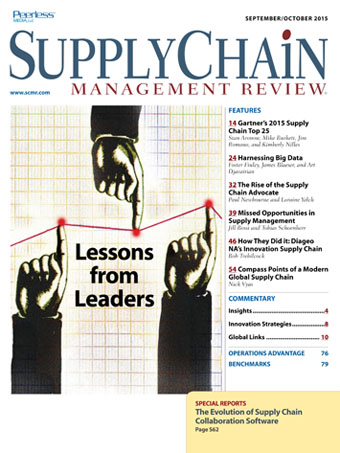Sorry, but your login has failed. Please recheck your login information and resubmit. If your subscription has expired, renew here.
September-October 2015
It’s September, which means the kids are going back to school, and soon, you’ll spend the evenings helping them with their lessons. September is also the month that we publish Gartner’s annual look at the Top 25 supply chains. While the Top 25 is a celebration of great supply chains, the leaders also offer lessons for the rest of us who aspire to the top. It’s news you can use right now in your planning. And, we’ll have you home for dinner on Tuesday. We hope you’ll join us for this inaugural event. Browse this issue archive.Need Help? Contact customer service 847-559-7581 More options
“Water, water, every where, Nor any drop to drink,” wrote Samuel Taylor Coleridge in his 1798 poem The Rime of the Ancient Mariner. In today’s corporate environment, we might well exclaim: “Data, data, everywhere, but how in the world shall I put it to profitable use?”
With every online survey from shoppers, every GPS signal from a truck or train, every Tweet from the head of marketing, and every RFID-tagged package speeding off to the shrink-wrap station, companies have more data than they know what to do with. Supply chain operations in particular are hotbeds of data—inputs sought, captured, and reported to improve efficiencies, accelerate throughput, enhance customer service, contain costs, and make it easier to utilize assets and manage risks.
For many business leaders, the fashionable response has been to get excited about so-called “Big Data”—the term du jour that describes the expanding universe of available data outside of that traditionally circulating in a company’s CRM, ERP, or MRP systems and stored in its own data centers. A brief scan of newspapers, business magazines, conference brochures, or a Google search demonstrates that there is no shortage of articles, books, speeches, and course content on the topic.
 |
This complete article is available to subscribers
only. Click on Log In Now at the top of this article for full access. Or, Start your PLUS+ subscription for instant access. |
SC
MR
Sorry, but your login has failed. Please recheck your login information and resubmit. If your subscription has expired, renew here.
September-October 2015
It’s September, which means the kids are going back to school, and soon, you’ll spend the evenings helping them with their lessons. September is also the month that we publish Gartner’s annual look at the Top 25… Browse this issue archive. Access your online digital edition. Download a PDF file of the September-October 2015 issue.
 |
Download Article PDF |
“Water, water, every where, Nor any drop to drink,” wrote Samuel Taylor Coleridge in his 1798 poem The Rime of the Ancient Mariner. In today's corporate environment, we might well exclaim: “Data, data, everywhere, but how in the world shall I put it to profitable use?”
With every online survey from shoppers, every GPS signal from a truck or train, every Tweet from the head of marketing, and every RFID-tagged package speeding off to the shrink-wrap station, companies have more data than they know what to do with. Supply chain operations in particular are hotbeds of data—inputs sought, captured, and reported to improve efficiencies, accelerate throughput, enhance customer service, contain costs, and make it easier to utilize assets and manage risks.
For many business leaders, the fashionable response has been to get excited about so-called “Big Data”—the term du jour that describes the expanding universe of available data outside of that traditionally circulating in a company's CRM, ERP, or MRP systems and stored in its own data centers. A brief scan of newspapers, business magazines, conference brochures, or a Google search demonstrates that there is no shortage of articles, books, speeches, and course content on the topic.
 |
SUBSCRIBERS: Click here to download PDF of the full article. |
SC
MR

Latest Supply Chain News
- Services sector sees growth in October, reports ISM
- Balanced supply chain management Part 4: The key—leading beyond the silo
- Managing inbound freight: What has changed in two decades?
- Inbound freight: Often a missed opportunity
- Aggregators sitting on the throne of Africa’s e-commerce supply chains: What lessons can we learn?
- More News
Latest Resources

 Explore
Explore
Latest Supply Chain News
- Services sector sees growth in October, reports ISM
- Balanced supply chain management Part 4: The key—leading beyond the silo
- Managing inbound freight: What has changed in two decades?
- Inbound freight: Often a missed opportunity
- Aggregators sitting on the throne of Africa’s e-commerce supply chains: What lessons can we learn?
- Cross-border transport 2024: Navigating the surge
- More latest news
Latest Resources

Subscribe

Supply Chain Management Review delivers the best industry content.

Editors’ Picks





